Patriots Draft Preview 2025: Offensive line
Our 2025 NFL Draft positional preview has reached what may be the biggest single need for the New England Patriots this offseason – the offensive line.
Last year, the Patriots had arguably the worst offensive line in the league. After failing to make any significant additions at any of the three spots that offseason, the team ended up using 10 different starting combinations and 22 total players on the offensive line during the year. The Patriots ended up allowing the highest pressure rate in the NFL (40.7% per Next Gen Stats) and ranked 26th in the NFL giving their running backs an average of just 1.02 yards per carry before contact.
The remaking of the offensive line is already underway. Free agent signing Morgan Moses gives the Patriots a right tackle, elevating the right side of the line with Mike Onwenu, who should return to right guard. Finding a long-term answer at right tackle to follow Moses, who turned 34 in March, is the biggest need here but not immediate, especially with Caedan Wallace already potentially filling that role.
As things move left though, the questions grow. That starts at center, where the team moved on from longtime starter and captain David Andrews. Veteran Garrett Bradbury was signed and is a strong candidate to take over as the starter with Ben Brown, Cole Strange, and Jake Andrews in the mix to compete for that job and/or the backup job as more developmental options. However, none of the three provide a clear long-term answer at the position.
Similarly at left guard, the Patriots have options but no clear-cut starter. After making multiple investments at the position in recent drafts the team has Sidy Sow and Layden Robinson, who have both started games at the spot in the past with mixed results. Strange has factored in here too, but it’s unclear if this new coaching staff will pick up where the previous staff left off and continue his move to center. Wes Schweitzer joined the team in free agency as a veteran option but has started just 13 games total since 2020.
Then, there’s left tackle. Vederian Lowe returns after starting the majority of the games on the left side for the Patriots last year – and that’s it. Unless the team is going to try again to move Wallace, a career right tackle, to the left side, there are no other left tackles on the Patriots’ roster. Finding a starter at this spot might be the most important task for the team this offseason, but finding a backup isn’t exactly low on the to-do list either. With 34-year-old Tyron Smith the only current free agent who reliably played the left side last year, at least one of not both of those players will have to come through the draft.
That brings us to this year’s offensive line class – one that is thin at the tackle position with most of the top players coming with some sort of significant question. On the interior there’s a bit more to work with, but that’s more in terms of depth than high-end talent.
How can the Patriots get the players they need in this year’s draft? Let’s take a look at their options…
Top of the draft tackles
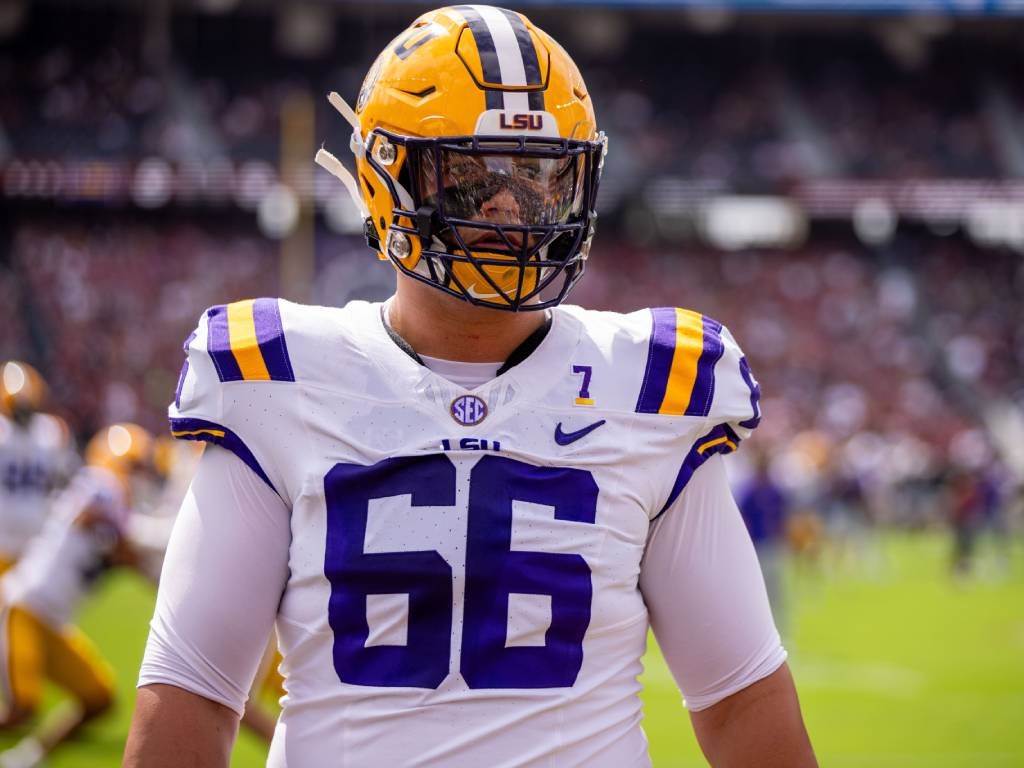
There’s a real chance the Patriots use their top selection to take a tackle. At his introductory press conference Mike Vrabel highlighted the importance of being able to protect the quarterback, and while the team has also spoken since about not wanting to ‘draft for need,’ at this point the left tackle hole is much more glaring than any other spot on the roster.
If the Patriots are going to take a tackle with the fourth overall pick (or after a slight trade down), odds are they’re choosing between one of two players – Will Campbell from LSU and Armand Membou from Missouri. Both have significant questions surrounding their projections.
For Campbell, the question regards his length and reach, despite him being 6-foot-6 and 319 pounds. While much has been made about Campbell’s arm length, it’s his wingspan that may concern teams more. Campbell’s wingspan measured in at 77 2/8-inches at his Pro Day (the NFL Combine numbers appear to be off across the board this year, so we’ll be focusing on showcase game and pro day numbers for all the prospects we talk about here). That would be the shortest of any tackle to measure in at any Combine since at least 2011 so he’s not just a bit under the threshold. Meanwhile, his arms measured in right at 33 inches, which is considered the threshold for tackles.
Membou checks the arm-length box at 34 4/8 inches and wingspan box at 81 inches, despite being what some people might call ‘short’ for the tackle position at 6-foot-4. He weighted in at 332 pounds. Instead, the concern with him from a Patriots point of view is he is a career right tackle. After playing on the interior in high school he won the right tackle job midway through his freshman year at Missouri, and never let it go.

Just like Campbell would be an outlier for his length, Membou switching sides successfully would also make him a rarity. In the past 10 years, Tristan Wirfs is the only player who has successfully made the switch to left tackle after primarily playing on the right side in college. Teams have tried in recent years but without success. Just last year the Titans used the 14th overall pick on J.C. Latham only to pay Dan Moore over $20 million a year on the first day of free agency this year to be able to move Latham back to the right side. (Tackles moving from left to right, like Joe Alt, have had more success).
The Patriots – or any other team looking for a left tackle – will have to ask themselves which outlier they want to take a chance on – Campbell making it worth with his reach or Membou being able to switch sides. At that point it will likely come down to – as it should – which player looks better on tape and put out more for scouts to see.
As a blindside protector in the SEC Campbell allowed just 18 pressures and two sacks last year. He plays like a true bully with his power and demeanor, and has the quickness to work is space and keep speed rushers to the outside. His length issues do show up at times, but he does a good job of adjusting and rarely gets beat by the same move twice. Last year saw Campbell have an uptick in penalties, with nine after having six called total over his first two years. Evaluators rave about his leadership and football character.
Playing on the right side in a more run-heavy offense at Missouri (Campbell had about 150 more pass blocking snaps than Membou in the same number of game sin 2024), Membou allowed just eight pressures without a sack. Membou has great body control and athleticism, which allow him to keep up with more dynamic rushers and recover when he gets beat initially – which isn’t often. Like Campbell, he plays with power and aggression.
Top 20 tackles
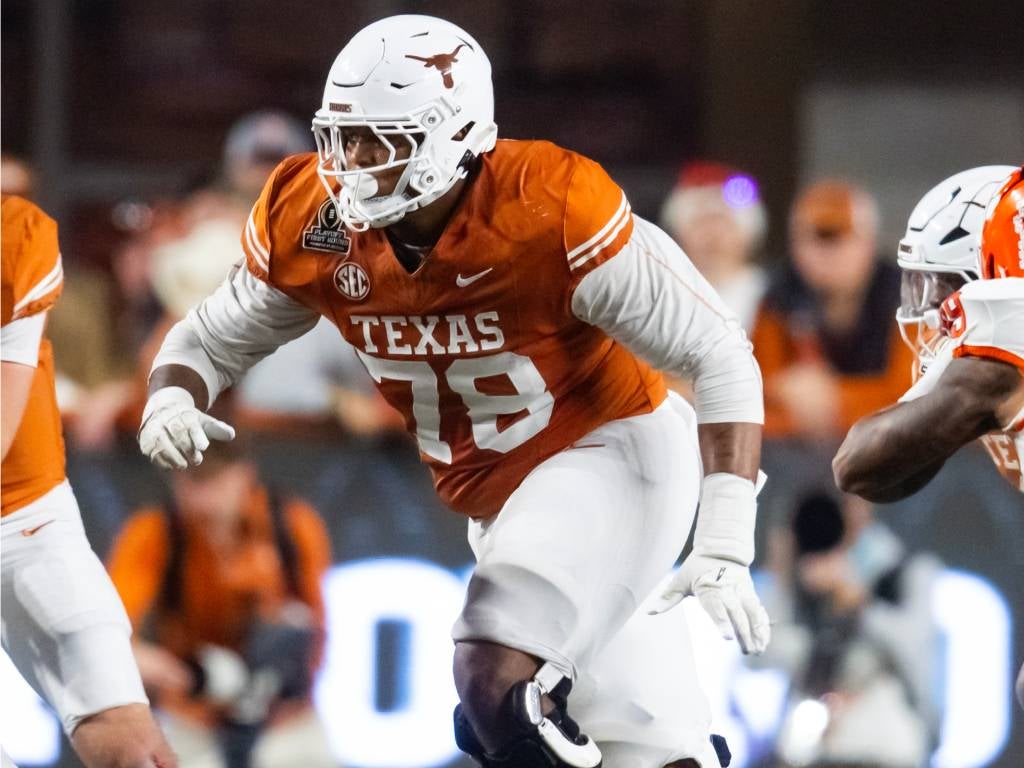
If the Patriots trade back, there are other options at tackle. One most people are probably familiar with is Kelvin Banks from Texas. Banks was initially projected to be a top pick, and expected to be in the mix with Campbell for the top tackle in the draft. However he seems to be dealing with whatever the opposite of ‘prospect fatigue’ is. He didn’t attend the Senior Bowl and didn’t stand out one way or the other at the Combine, which seems to have dropped him from many people’s conversations.
That doesn’t mean he shouldn’t be considered as an option for the Patriots. Banks has good size for the position at 6-foot-5, 315 pounds. His arm length from his pro day hasn’t been made public, but based on other results it’s safe to assume his arm length goes beyond the 33 1/2 he measured in with at the Combine.
Right now, Banks further ahead as a run blocker than pass blocker. He plays with a high motor and is technically sound, and is another high-athleticism tackle. However, he could be better against power rushers, and will need to be better when rushers come to him at the next level.
Because of his makeup, some teams may see him as a guard given that weakness won’t be as much of an issue inside. However, teams that are willing to be patient while he adds more power could end up with a long-term answer at one of the tackle spots.
Speaking of patience, the other tackle projected to go in the 10-25 range is another long-term option. Josh Simmons from Ohio State got off to a great start in the first half of the 2024 season, after a solid 2023. He showed good movement skills, while overpowering defenders both as a run and pass blocker. However that was against the weaker portion of the Buckeyes’ schedule, and he suffered a season-ending knee injury in mid-October.
It was later revealed that Simmons suffered a torn patellar tendon, the same injury that kept Cole Strange out for a full calendar year in 2024. Simmons is believed to be ahead of schedule and did some on-field work at his pro day, but looking at previous examples of players coming back from this injury there’s a chance he misses some of if not all of his rookie season.
Some teams may be in a position to draft a player under those circumstances, and have him contribute down the line. For the Patriots, the question is if they can afford to have their first-round pick potentially not contribute in 2025, especially at the left tackle position where there is an immediate need. Plus, there’s no guarantee he’ll be the same player when he returns. They’d need to find a bridge tackle elsewhere, at which point it might make more sense to play that player and address the long-term tackle need in what is expected to be a stronger class next year.
Trade up candidates
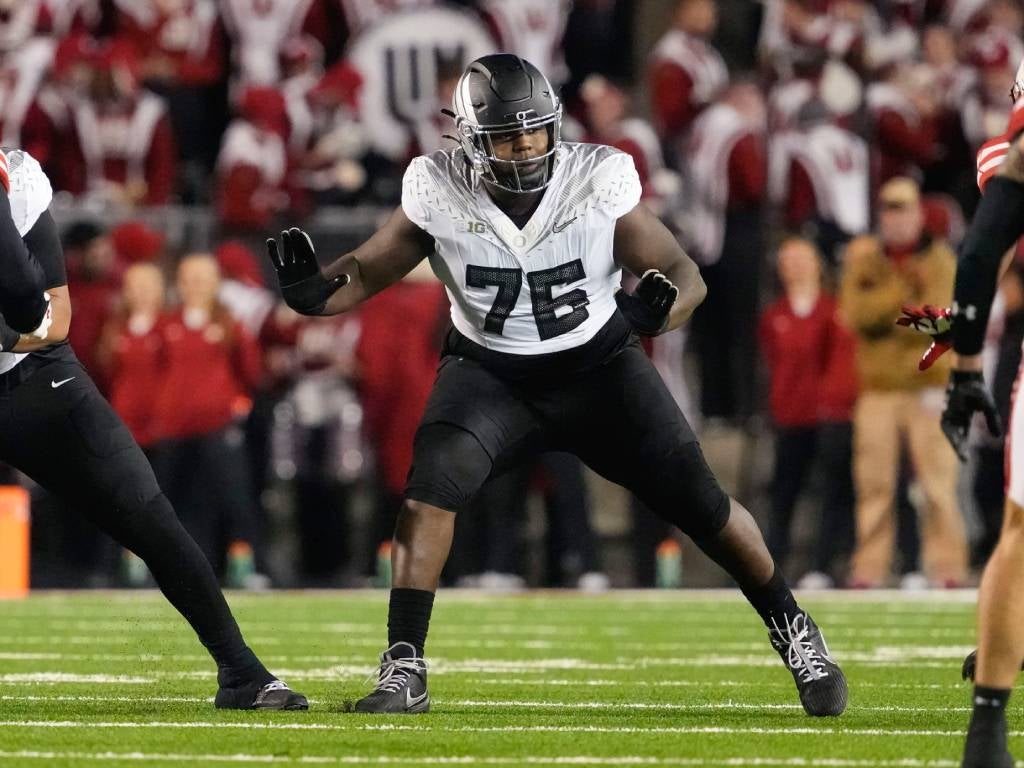
If the Patriots don’t address tackle with their top pick they still could have a chance to get a player who can play on the left side. However, the options are limited.
The next players up are Josh Conerly from Oregon and Aireontae Ersery from Minnesota. The big question right now is will either or both players make it to the Patriots’ second pick at No. 38? Some projections have that being the case right now, but that may be optimistic, especially with so many tackle-needy teams sitting at the bottom of the first round.
As we saw last year, NFL teams are desperate for tackles with a shortage at the position in the league. There was a massive run at the position starting late in the first round, with multiple players going a round or more higher that projected. If that’s the case this year, it’s tough to see how Conerly and Ersery both fall. The Patriots may have to trade back up into the first round – something they tried and failed to do last year – to get their guy.
With Conerly and Ersery, it’s more about stylistic fit than overall ability. Conerly is the more consistsent of the two. At 6-foot-5, 311 pounds with 34-inch arms he moves well and is technically sound. However, bigger rushers can push him around at times.
Ersery has significant potential in large part thanks to his size at 6-foot-6, 331 pounds with 34-inch arms. He has a rare combination of size and athleticism, but his height can work against him at times. His college tape is more sporadic, but does include a very strong performance against Abdul Carter that points to a higher ceiling.
Day 2 tackles
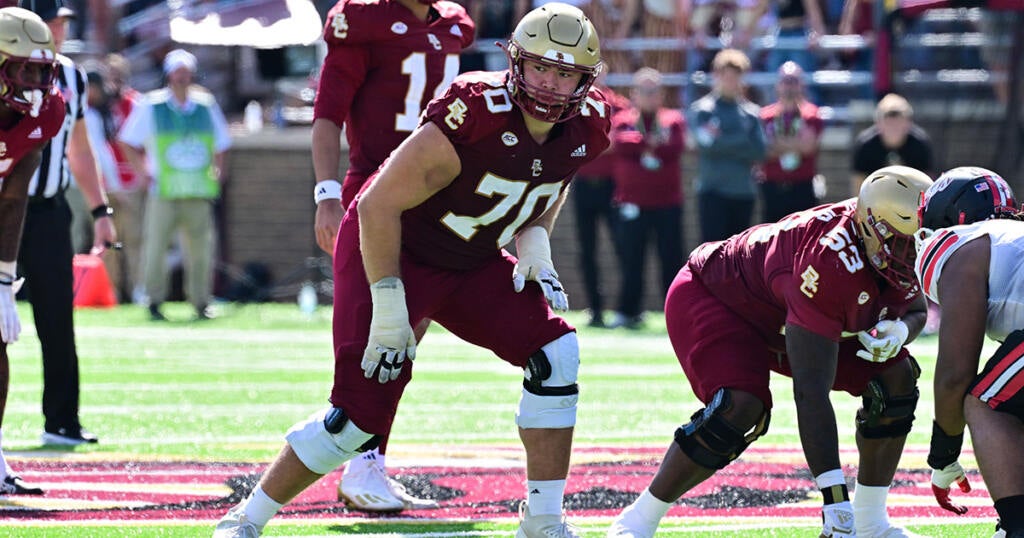
After Conerly and Ersery is where this tackle class drops off, especially on the left side. The only other left tackles projected to go in the top 100 are Anthony Belton from NC State and Charles Grant from William & Mary, although both are right on the line.
Belton is a true upside prospect. He’s got tremendous size at 6-foot-6, 336 pounds with 34 5/8-inch arms and plays with excellent power, but for the most part he won just with his raw strength at the college level. There’s still plenty to work on with his game, and he may ultimately end up at right tackle in the NFL (he certainly is a potential swing tackle in the Patriots’ system).
Grant Was a four-year starter and two-time All-American at left tackle for W&M at the FCS level. At 6-foot-5, 311 pounds with arms that measured in at almost 35 inches at the Combine, he has elite reach and room to bulk up as he gets ready for the step up in competition. In pass protection in particular he plays with urgency and shows a great understanding of what his assignment is and how defenders are trying to attack him. He’s another ceiling pick, but is on the older size after playing five years of college football.
The rest of the top-100 group is true right tackles. If the Patriots want to get ahead of finding the next man up after Morgan Moses, this could be where they make that pick.
From a Patriots standpoint, that group is highlighted by Ozzy Trapilo from Boston College. Trapilo played for current Patriots offensive line coach Doug Marrone last year at BC, making a natural connection. The Norwell native stands 6-foot-8, 316 pounds and anchored the right side for the Eagles for the last two years after playing on the left side in 2022. He’s a smart, technically sound player who has starting upside on the right side in the NFL who could also be a swing tackle.
The other tackles in this range are Cameron Williams from Texas, Emery Jones from LSU, and Marcus Mbow from Purdue. Both Williams and Jones were initially projected to be top-50 picks but struggled in 2024. Jones has more experience as a three-year starter, while Williams is more of a projection with only one year as a full-time starter under his belt.
Mbow started his career at Purdue at guard before moving to tackle last year. He has the potential to be impacted as much as anybody by the incorrect arm length measurements, with the Combine measurement dropping him below the 33-inch threshold from the Senior Bowl. Teams will have to figure out where they think he fits best, and he may get a chance to play both spots initially in his first training camp.
Top 100 interior offensive linemen
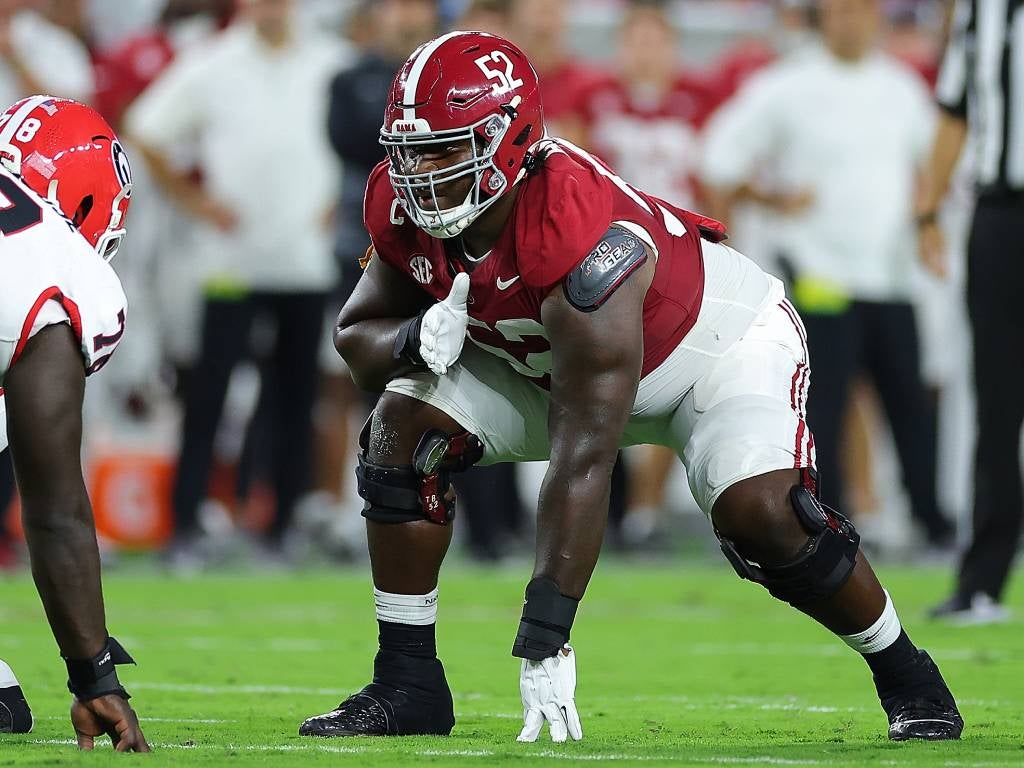
Before we move on to Day 3, lets take a look at the top guards and centers in this draft.
At guard, both Tyler Booker from Alabama and Grey Zabel from North Dakota State have a chance to go in the first round. On the off chance one falls to Pick 38 they could be a more definitive answer for the Patriots at left guard, if the team is comfortable drafting a guard that high. Booker is a true mauler while Zabel is slightly smaller but more technically sound. Zabel is making the move from left tackle due to arm length, and may get some looks at center as well.
Later on Day 2, there are a couple of other players projected to make the move from tackle to guard. Donovan Jackson from Ohio State was actually a guard for most of his career, but had to move to tackle last year due to injuries. Guard is his natural position though given he is better facing defenders head-on, and is more of a people-mover than a blocker in space.
Jonah Savaiinaea from Arizona played both tackle spots last year after being a guard earlier in his career. He projects as a better player inside but could offer versatility across the board in the NFL. He was one of the top performers at this year’s Combine.
In terms of true guards, Tate Ratledge stands out on Day 2 after Booker. Ratledge was a three-year starter for the Bulldogs, and that experience shows in the way he plays. He does a good job of picking up defensive line games, and has the quickness to react in time. At the Combine, he was one of the best testers of the offensive linemen, running a 4.97 40 at 6-foot-6, 308 pounds.
There is also one center projected to go in the top 100 – Georgia’s Jared Wilson. Like Ratledge, Wilson was one of the top testers at this year’s Combine. 2024 was his first and only year as a starter, but he’s shown a lot to like in his relatively limited reps. He’s viewed by some as ‘undersized’ for the position at 6-foot-3, 310 pounds but makes up for it with his athleticism and instincts.
Early Day 3 tackles
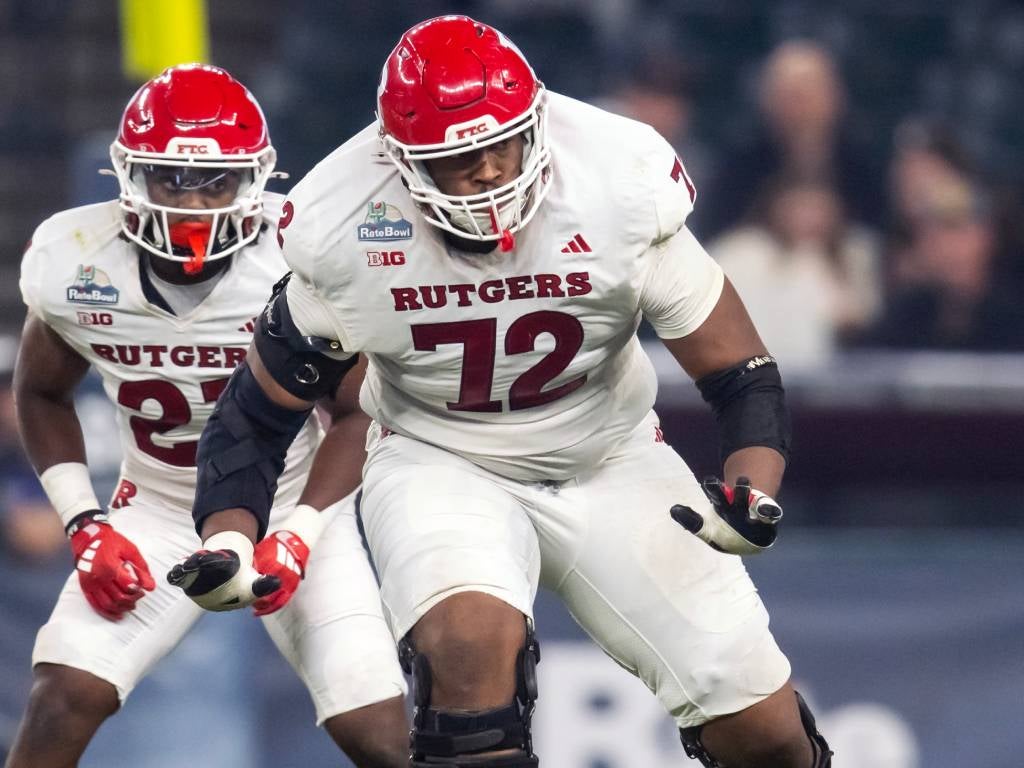
At this point, we’re onto true project players at the tackle position. As far as projects go, few have the kind of natural tools that Hollin Pierce from Rutgers does. Pierce is among the biggest players in this draft, checking in at 6-foot-8, 341 pounds with 36 5/6-inch arms. He’s also one of the most experienced starting two full seasons at right tackle for the Scarlet Knights before flipping to the left side and starting there for the last two years. In all that time, he was called four just four penalties.
While his size is one of Pierce’s biggest strengths, it can also work against him at times. He can go power-for-power with just about any player but smaller and quicker rushers do get around him when forcing him to keep up in space. With that he projects more as a right tackle if he’s going to start in the NFL, but his swing tackle ability certainly is notable.
Another potential swing tackle is Logan Brown from Kansas, although he’s less experienced. Brown made 14 career starts over six college seasons, with 11 of those coming last year at right tackle. That inexperience shows up at times but Brown does move well at 6-foot-6, 311 pounds with 34 3/4-inch arms. His pass blocking is ahead of his run blocking at this point. Teams may also look closely at an “internal incident” that led to Brown being dismissed from the Wisconsin program mid-season in 2022.
As we move from tackles to guards, Chase Lundt from UConn is a bit of a tweener with arms right on the 33-inch margin at 6-foot-7, 304 pounds. A true right tackle with four full seasons of experience starting at the position Lundt does a good job of controlling rushers once engaged but has room to improve getting into his blocks. Because of that and his arm length, some teams may see him as a guard.
Early Day 3 interior offensive linemen
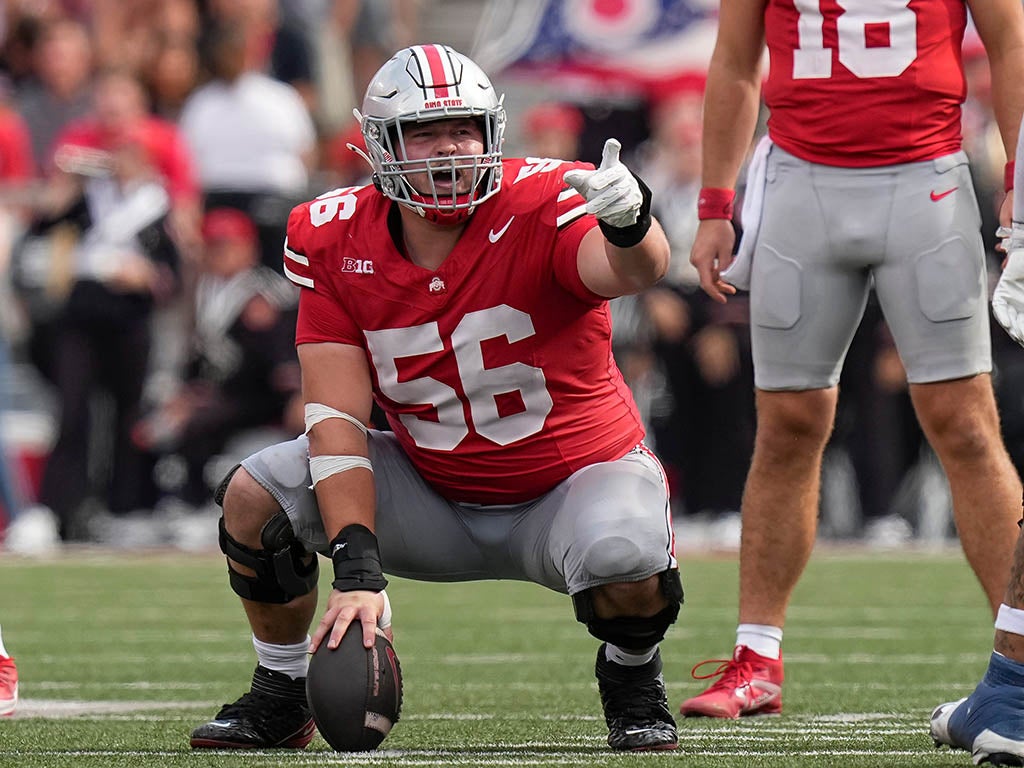
We already talked about two of Georgia’s three starters on the interior of the offensive line, but their left guard Dylan Fairchild is expected to be drafted as well – just a little bit later. A two-year starter at left guard, Fairchild is quick and athletic at 6-foot-5, 318 pounds but will need to add more power to his game at the next level.
At this point in the draft versatility is key, which should get Miles Frazier from LSU a look. He started 11 games for Florida International to start his college career, then at LSU started 10 games at left guard, 14 at right guard, and two at right tackle over the last three years. At 6-foot-6, 317 pounds he projects primarily as a guard at the next level. Frazier will need to clean up his game technically, especially with his lower half, in the NFL.
Another versatile player in this range is Joshua Gray from Oregon State. Gray started 44 games at left tackle between 2020 and 2023, then last year moved inside to left guard while being named a team captain. At 6-foot-5, 299 with 32-inch arms Gray mainly projects to stay at guard at the next level but also got some work at center at the Shrine Bowl. His experience and football IQ would play well at that spot. However he’s an older prospect (he’s been in college since 2018), which generally means a limited ceiling.
For teams looking for value and looking for a center, this is where Seth McLaughlin from Ohio State is expected to be picked. McLaughlin started at center for Alabama for two years, then transferred to Ohio State last year after Nick Saban’s retirement. In Columbus he was an anchor for the Buckeyes’ offensive line and won the Rimington Trophy as the nation’s top center.
McLaughlin won that award despite missing the final six games of the year due to a torn Achilles. Had he finished the season healthy, he most likely would have been a top-100 pick and the first center off the board in this draft. Instead he’s projected to go on Day 3, but for a team like the Patriots that needs more of a long-term than immediate need at center, he’d be a logical pick who could learn behind the scenes in 2025 then compete for the starting job in 2026.
Late Day 3 tackles
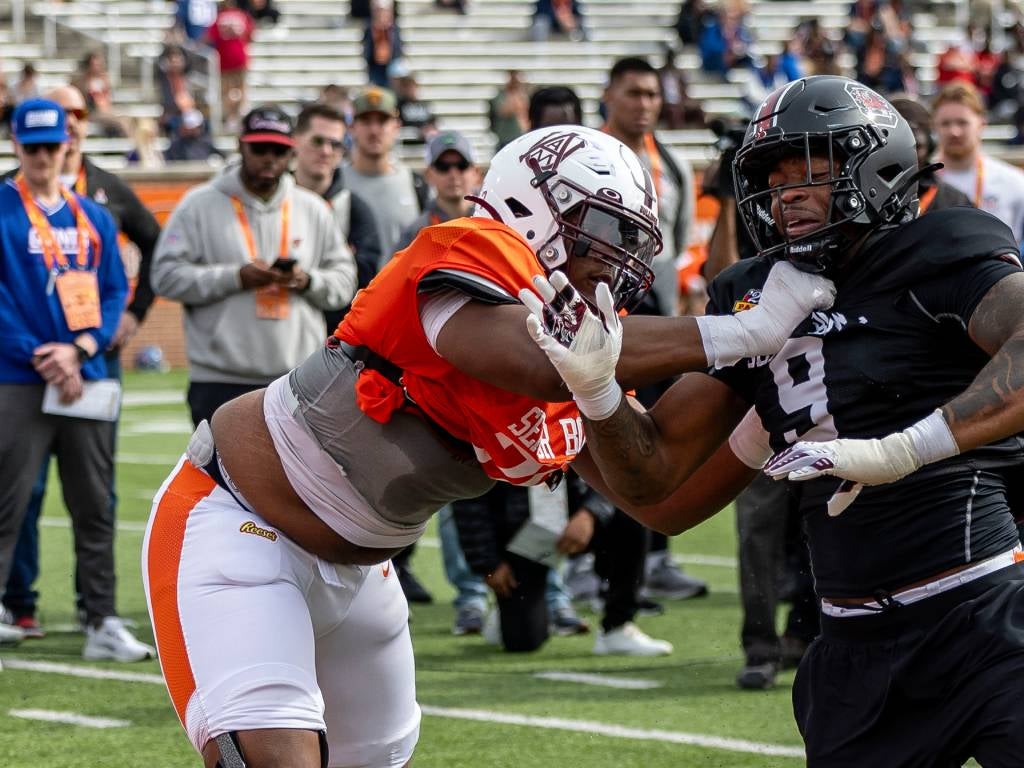
Starting off this group with Carson Vinson from Alabama A&M, who was one of the standouts at the Senior Bowl. The step up in competition didn’t look to phase Vinson after four years as a starter at the FCS level. Vinson wins with size (6-foot-7, 314 pounds with 35 1/8-inch arms) and athleticism, and has room on his frame to add more power. Although he was a four-year starter at left tackle and checks the tackle measurables, he also has traits that could allow him to play some guard if needed as well.
Vinson’s traits and experience on the left side make him a logical Patriots fit. Another player matching that description is Gerad Christian-Lichtenhan. At 6-foot-8, 328 pounds with 35 7/8-inch arms Christian-Lichtenhan was a three-year starter at left tackle at the college level, with two of those years coming at Colorado before he transferred to Oregon State last year. He took a significant jump last year – especially as a pass blocker after struggling in 2023 – and teams will have to ask themselves if they believe his 2024 season was a real step forward or a product of playing lesser competition (Oregon State played just three Power 4 teams in 2024).
Brandon Crenshaw-Dickson from Florida is another bigger tackle with experience, but primarily on the right side. He started 36 games in college, with 31 starts at right tackle. That’s where he primarily projects in the NFL, winning primarily by overpowering opponents and becoming less effective when he has to block in space.
Late Day 3 interior offensive linemen
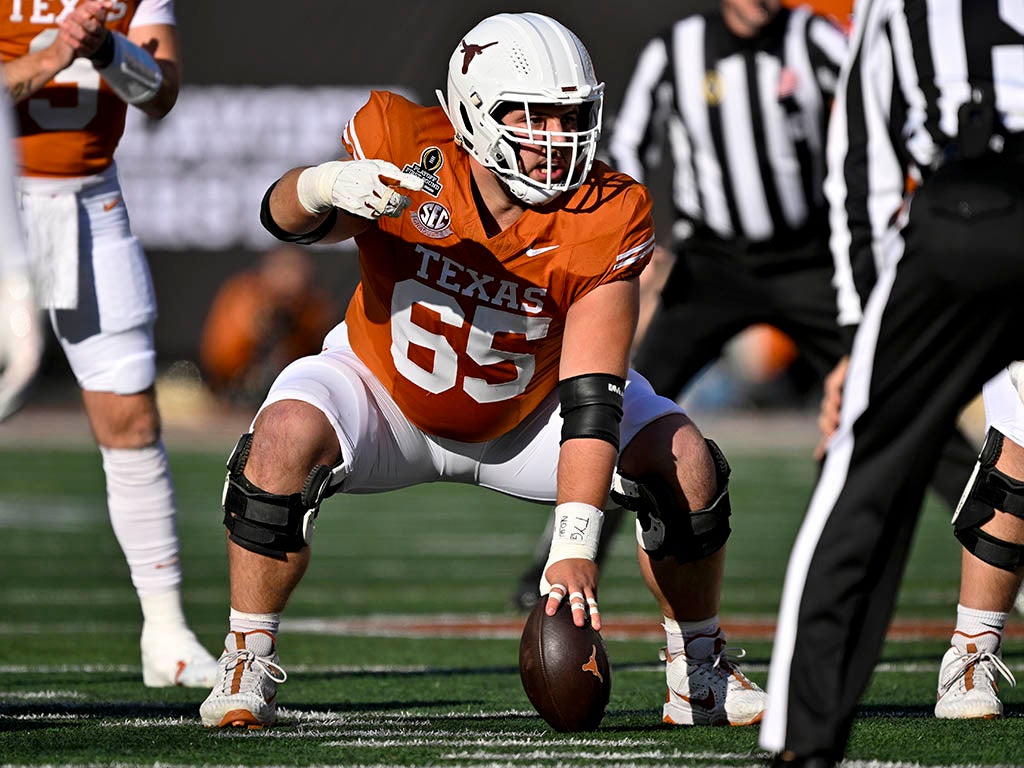
This is where the depth at center in this class really starts to come through. Again, a big name for Patriots fans to know is a local product – Boston College center Drew Kendall. Kendall is a center-only prospect who plays a physically, technically-sound game. His experience as a three-year starter, familiarity with the coaching staff, and approach to the game make him a logical Patriots pick.
In most drafts, a player like Jake Majors from Texas may go earlier but as a center-only prospect in a draft loaded with interior offensive linemen that can play multiple positions, he gets knocked down the board. He started a school record 57 games for the Longhorns, and that experience shows both pre- and post-snap. According to a scout that talked to NFL.com’s Lance Zierlein, “That [Texas] building is crazy about him because of his leadership and just how sharp he is. He can make protection adjustments on the fly like an NFL veteran.” However, concerns about size (6-foot-3, 306 pounds with 30 3/8-inch arms) leave him projected to go later on Day 3.
As far as guards in this range, the top player may be Clay Webb from Jacksonville State – another Senior Bowl standout. Webb was initially recruited to Georgia was a five-star center, but after seeing limited playing time in his first three seasons transferred to Jax State and moved to guard. He’s a bit undersized for the guard position but has the movement skills and instincts to help compensate. As a pro he should get looks at both positions early on.


